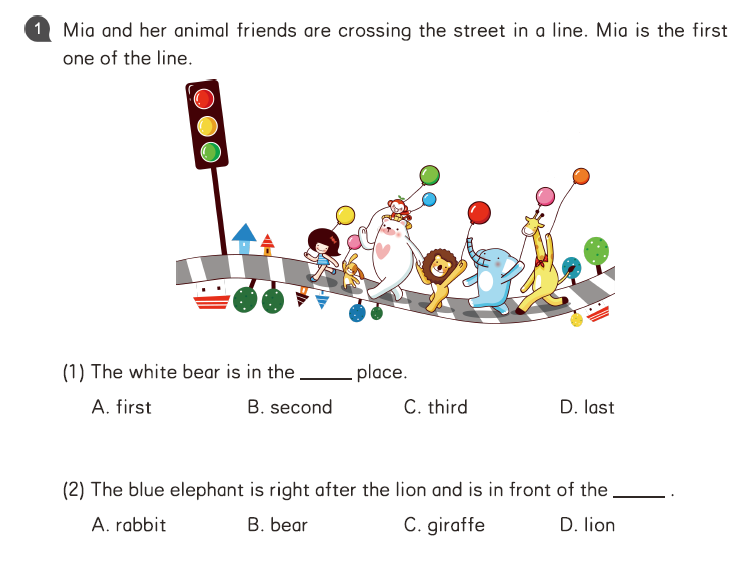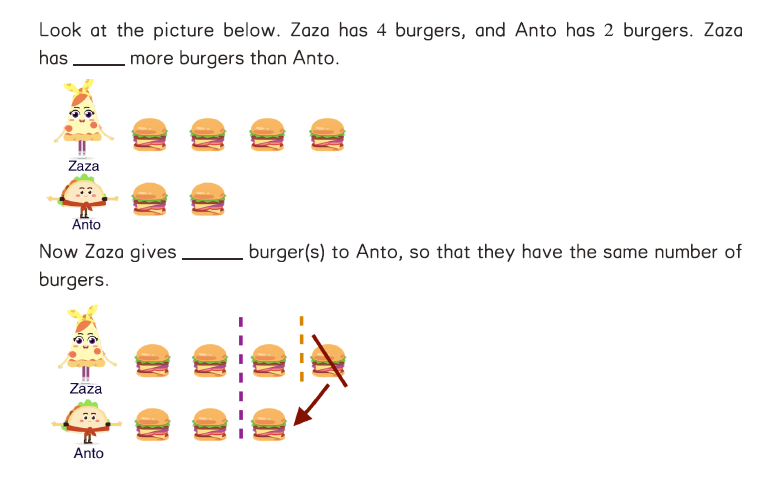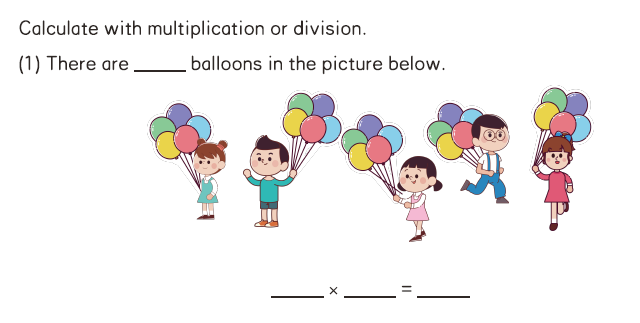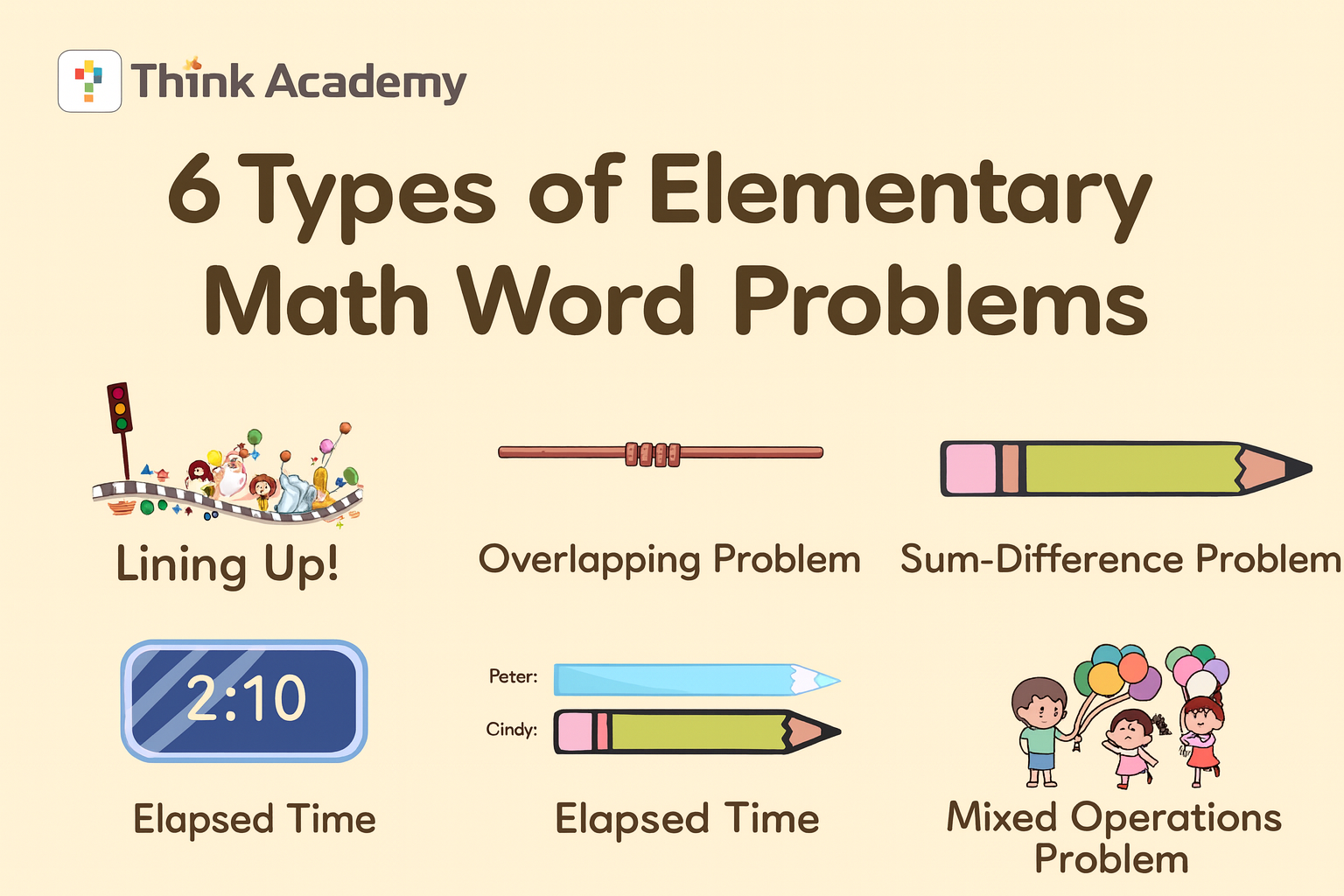Introduction
Word problems are one of the most important parts of elementary math. Unlike direct calculation, they require children to apply math in real-life situations—from lining up with friends to figuring out how long a trip will take. At Think Academy Canada, our lower-grade math curriculum introduces students to six classic types of word problems. Mastering these helps build logical thinking, problem-solving ability, and confidence for future math learning. This approach is also aligned with the Ontario Mathematics Curriculum for Grades 1–8, which emphasizes problem-solving and real-life applications.
1. Lining Up Problems
Concept: These problems involve ordering, positions, and logical deduction. Children need to carefully track who is in front, who is behind, and what position each person or object holds.
Example:

Another example:
There are 8 students in a row. John is standing behind Sarah and in front of Emily. Who is the 5th student in the line?
Why it matters:
By practicing lining-up questions, children gain a strong grasp of ordinal numbers (first, second, third) and relative positions. These skills directly support future geometry (coordinates and directions) and logical reasoning in puzzles, competitions, and daily decision-making.
2. Move for Fairness Problems
Concept: These problems teach balancing quantities by transferring items. Children learn how to “level out” differences between two or more groups.
Example:

Another example:
Emma has 10 apples and Noah has 6 apples. How many apples should Emma give to Noah so both have an equal share?
Why it matters:
This type introduces the foundation of algebra—setting up an equation without explicitly writing one. Students begin to understand equality and balance. Later, this skill connects to solving equations like x + 3 = 7. Beyond math, children also build a sense of fairness in real life.
3. Overlapping Problems
Concept: These problems involve combining lengths, areas, or totals while accounting for the part that is shared. Children must carefully distinguish between “whole” and “overlap.”
Example:

Another example:
Two blankets cover a bed. One is 150 cm long, the other 130 cm long, and they overlap by 20 cm. What is the total length covered?
Why it matters:
Math World Problems like overlapping problems teach precision and critical thinking. Students learn not to double-count, a skill that becomes essential in advanced topics such as probability, set theory (Venn diagrams), and real-world measurement tasks.
4. Elapsed Time Problems
Concept: These math word problems ask students to work with start time, elapsed time, and end time, requiring both addition and subtraction of minutes and hours.
Example:

Another example:
The movie starts at 6:25 and ends at 8:10. How long does the movie last?
Why it matters:
Time is one of the most practical applications of math. Children use it daily—planning when to wake up, estimating travel time, and keeping track of activities. By mastering elapsed time, students also strengthen number-line thinking, which is critical for fractions and negative numbers later.
5. Sum-Difference Problems
Concept: These problems give a total and a difference, asking students to find unknown quantities. It’s an early introduction to systems of equations.
Example:

Another example:
Two baskets of fruit weigh 30 pounds in total. One basket is 6 pounds heavier than the other. How much does each basket weigh?
Why it matters:
Sum-difference questions train children to break down problems into two unknowns. This thinking connects directly to algebra and word problems in middle school. It also builds persistence, since children must think beyond single-step solutions.
6. Mixed Operations Problems
Concept: These problems combine multiple operations (addition, subtraction, multiplication, and division). Students must carefully plan the order of steps to arrive at the answer.
Example:

Another example:
There are 24 candies. First, divide them equally among 4 children. Then, each child eats 2 candies. How many candies are left in total?
Why it matters:
Mixed operations train children to manage multi-step reasoning. They learn to pause, think, and plan—skills that help with problem-solving endurance in both academics and real life. This type of problem also mirrors real situations, like budgeting pocket money or planning group activities.
Conclusion
These six types of word problems: Lining Up, Move for Fairness, Overlapping, Elapsed Time, Sum-Difference, and Mixed Operations. They are essential building blocks for elementary students. They strengthen logical reasoning, connect math to everyday life, and prepare children for advanced problem-solving in later grades.
At Think Academy Canada, our Elementary Math Courses are designed to cover all six problem types with interactive lessons, step-by-step teaching methods, and fun practice worksheets. By practicing systematically, children not only improve their math skills but also gain confidence, creativity, and a love for learning.
Learn more about our Lower-Grade Math Courses or sign up for a free evaluation.



